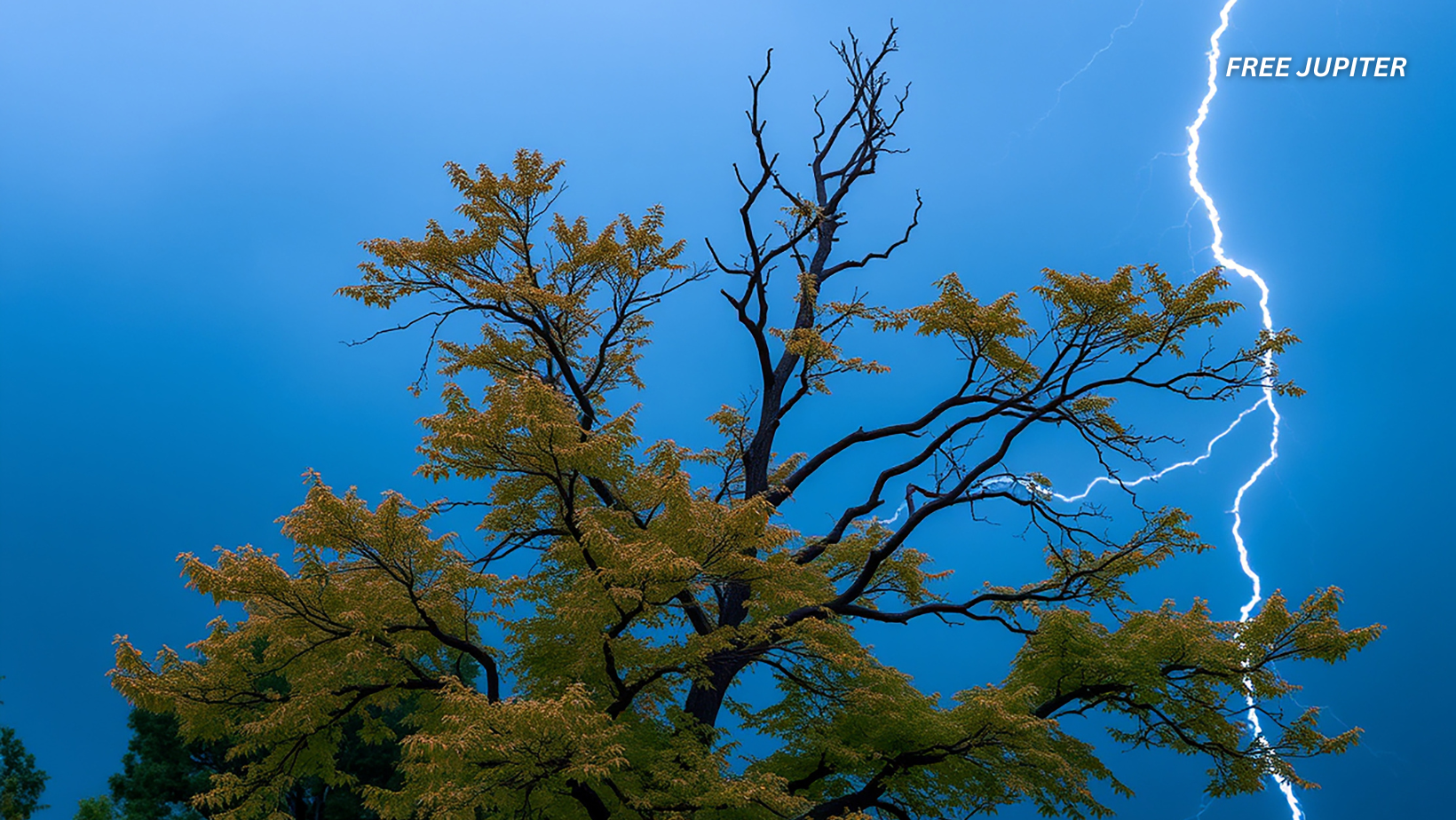Friendly Note: FreeJupiter.com shares general info for curious minds 🌟 Please fact-check all claims—and always check health matters with a professional 💙
When most people picture lightning, they probably imagine a thunderstorm booming overhead, maybe a flickering light bulb, or the classic horror-movie moment where a tree splits in two. It’s dramatic. It’s loud. It’s rare enough to feel thrilling.
But behind that dramatic flair is a quiet reality few ever consider: lightning is a silent tree assassin, and it’s much busier than anyone previously thought.
A groundbreaking global study now estimates that lightning kills around 320 million trees every single year. And that’s not just a cool fact to pull out at trivia night—it has serious implications for climate change, biodiversity, and the future of Earth’s forests.
A Forest Murder Mystery Solved by Science
Figuring out what killed a tree is harder than you might think. Trees don’t come with toe tags or autopsy reports. Many die slowly, their symptoms masked by time, weather, and decomposition. Some trees die standing. Others fall and rot into the forest floor, becoming one with the soil again without anyone taking note of how they got there.
Scientists have long known that lightning plays a role in forest disturbances. But how many trees it actually kills? That was a mystery.
Now, researchers from the Technical University of Munich (TUM) have cracked the case—at least partially—using an impressively geeky blend of mathematics, drones, satellites, cameras, and good old-fashioned fieldwork.
And the numbers they came up with? Shocking. (Pun still unintentional.)
Just How Many Trees Are We Talking About.
The team found that each year, between 301 to 340 million trees are killed directly by lightning. And we’re talking direct hits here—these numbers don’t include trees that later die in wildfires caused by lightning, which would add millions more to the total.
Even more alarming: among those trees, around 24 to 36 million are large, old-growth trees—the elders of the forest, with trunks over 60 centimeters thick. These giants are the VIPs of carbon storage, wildlife habitat, and ecological balance.
But once they’re gone, they don’t just leave a hole in the canopy—they release stored carbon back into the atmosphere. The researchers estimate that these deaths contribute up to 1.09 billion tons of carbon dioxide annually. That’s more carbon than many countries produce in a year.
Read more: Cook Pine Trees Mysteriously Always Lean Toward the Equator—And Science Has an Idea Why
How Do You Even Count Lightning Tree Deaths?
Since trees don’t send out distress signals when struck, the researchers had to get creative. They started with Barro Colorado Island (BCI) in Panama, a tropical rainforest island that’s basically a giant natural laboratory.
There, another team had set up high-speed cameras to catch lightning in the act. Once a bolt struck, drones and researchers on foot would rush to the scene to document the damage. They found something fascinating: lightning didn’t just hit one tree and call it a day. It often spread to others nearby through something called a flashover—where electricity jumps across the air from one treetop to another, a bit like nature playing hopscotch with plasma.
On average, one strike killed 3.5 trees. In some cases, lightning damage extended up to 45 meters (almost 150 feet) from the original strike point.
Armed with this data, the TUM team created a model and ran simulations that allowed them to scale up their findings globally. They combined this with two major datasets: one from space-based lightning detectors and another from ground-based lightning frequency maps.
The Global Lightning Scene
Their analysis showed that 286 to 328 million lightning bolts hit the Earth’s surface every year, mostly over land and especially in the tropics, where warm air fuels more thunderstorms. That aligns with what we already knew about storm-heavy regions like the Amazon Basin, Central Africa, and Southeast Asia.
But here’s where things get even more interesting—and a little concerning.
It’s Not Just the Tropics Anymore
At present, most of these lightning-triggered tree deaths are happening in tropical regions. But climate models suggest this is changing. As global temperatures rise, lightning frequency is expected to increase, especially in mid- and high-latitude regions like the U.S., Canada, parts of Europe, and Russia.
That means forests in temperate and boreal zones—places not typically associated with tropical-style lightning mayhem—could be the next frontier for lightning-induced tree loss.
One model even predicts that a 25 to 50 percent increase in lightning could result in a 9 to 18 percent rise in large-tree mortality. That’s significant, particularly for ecosystems already stressed by droughts, deforestation, and invasive species.
Read more: How Dolphins Developed the Ability to ‘See’ Underwater with Sound, Explained by Science
Why Big Trees Matter More Than You Think
Big trees aren’t just tall—they’re essential.
- They store more carbon than smaller trees, acting as massive “carbon sinks” that help buffer climate change.
- They provide homes for countless species, from birds and bats to mosses and insects.
- They play a critical role in water cycles, helping forests retain moisture and regulate rainfall.
Losing them has ripple effects far beyond the stump they leave behind. It’s like removing anchor stones from a temple—everything else becomes a little less stable.
A Blind Spot in Climate Models
Despite their importance, lightning-induced tree deaths are rarely factored into climate and ecological models. Most researchers focus on deforestation, logging, drought, pests, and fire. Lightning? It’s been flying under the radar.
But this new study argues that lightning should be taken seriously as a major force shaping forest ecosystems. If we’re trying to model carbon storage accurately, or predict how forests will change in the future, then ignoring lightning is like leaving a puzzle piece under the couch.
Beyond the Science: What Can Be Done?
Now, you might be wondering: “Can we stop lightning from killing trees?”
Well… not exactly.
Lightning is a natural phenomenon that has been shaping ecosystems for millions of years. In many ways, it’s part of a healthy forest cycle. It creates gaps in the canopy, opens up space for new growth, and even helps some fire-adapted species germinate.
But what we can do is start paying more attention. Conservation strategies and reforestation projects can prioritize resilient species or diverse planting schemes that allow forests to bounce back better. And by including lightning data in climate models, we can paint a more accurate picture of how forests—and the planet—are really doing.
Read more: If You Turn Down the Radio to See Better, You May Be Gifted in These 8 Weird Ways
Final Thoughts: Lightning’s Quiet Forest Rebellion
Lightning may strike in a flash, but its impact lingers for years. This study reveals that each bolt could be a silent blow to our forests’ health—and by extension, to our climate.
So next time you hear thunder rumbling in the distance, think beyond the drama. Somewhere out there, a towering tree might have just been felled by nature’s electric finger. And in that quiet fall, a forest changes, carbon is released, and Earth’s delicate balance shifts—ever so slightly.
What we choose to do with this knowledge, however, might just tip the scale back in our favor.










